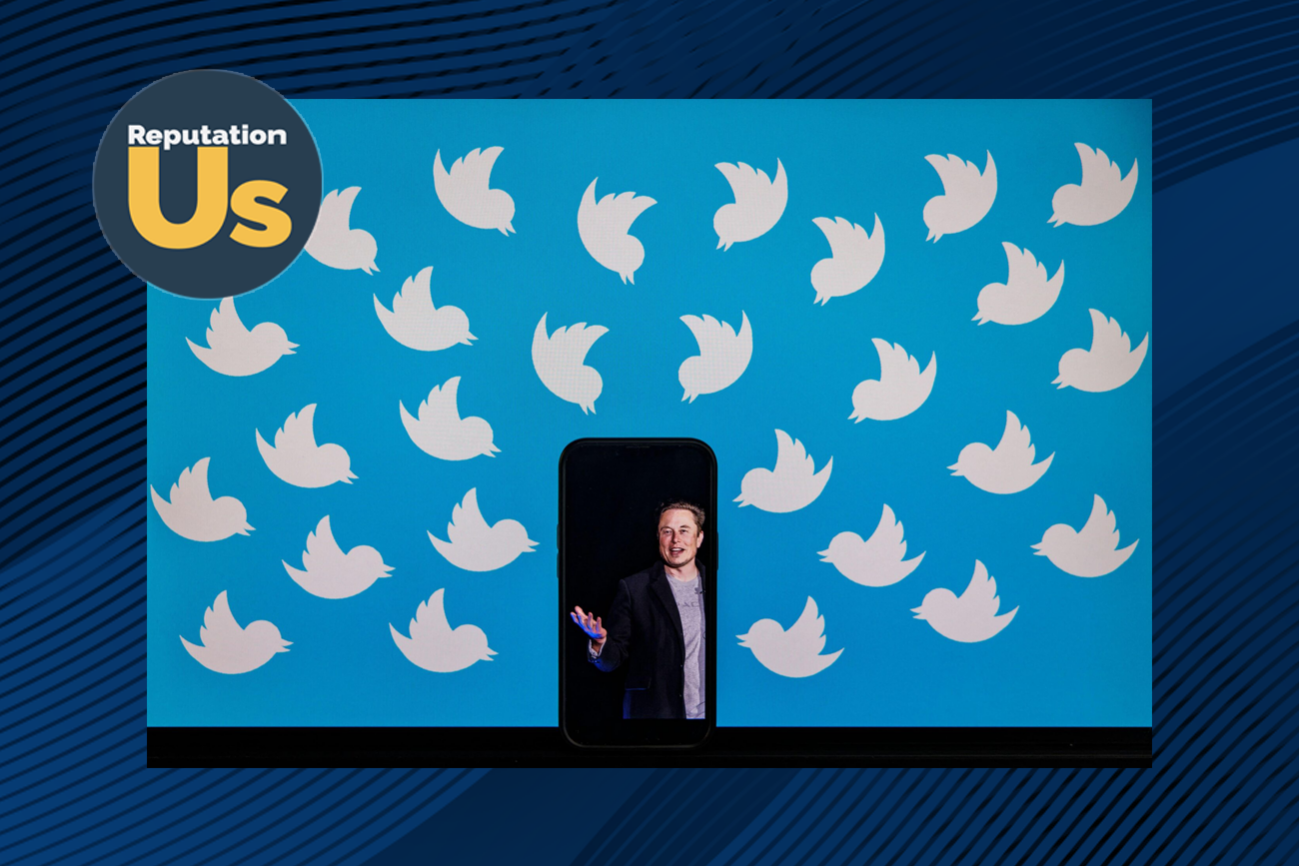From the November 28, 2022 issue of Financial Brand
Elon Musk is revolutionizing Twitter — for good or ill, depending on which of a million fiery headlines you agree with. Whether or not Musk succeeds remains to be seen, but behind those headlines is a mission-oriented strategy, a performance initiative, and a customer plan that bank and credit union leaders should learn from.
Elon Musk’s approach to the acquisition of Twitter — via inflammatory tweets, friends’ money, and the Delaware Chancery Court — has spilled a lot of ink. His leadership decisions have spilled even more.
Bank and credit union leaders are looking on — perhaps in horror, perhaps in amusement — but they do look on.
“Since taking over Twitter, Musk has put the world on notice that he’s in charge and more changes are coming,” Casey Boggs, president of the reputation and crisis management company ReputationUs, tells The Financial Brand. “His actions, more than his intriguing behavior, raise both eyebrows and publicity. If nothing else, Musk knows how to attract attention and garner captivating headlines.”
Those headlines, hard to miss as they are, often obscure very real leadership decisions about strategy, employee performance and customers. Such decisions have predictable consequences.
Whether it’s a leadership playbook worth emulating — or a cautionary tale — banking leaders can learn from Musk’s business drama in ways that the headlines don’t even hint at.
Lesson 1: Inspire Urgency and a Sense of Mission
One of a leader’s primary responsibilities is to execute on a strategy. Musk’s ultimate goal is to make Twitter profitable. He’s got a long way to go.
William Mills, chief executive of the William Mills Agency, a public relations and marketing firm specializing in financial services, predicts that between the lack of profitability and European regulators, the company will soon “be owned by the large institutions and offshore entities that lent most of the capital required for Musk to buy Twitter.”
Indeed, Twitter has rarely been profitable in its history and Musk said in November 2022 the company was losing $4 million a day. He (and his creditors) must recoup the $44 billion purchase price. And Tesla stock — Musk’s largest source of collateral, which is from his only publicly traded company — is cratering.
“If nothing else, Musk knows how to attract attention and garner captivating headlines.”
— Casey Boggs, ReputationUs
Musk’s concerns “are very valid,” says Vipula Gandhi, Global Head of Enterprise and Managing Partner at Gallup, in an interview. “He must worry about productivity. Bankruptcy is a reality. He has to create a sense of urgency as Twitter loses millions of dollars. He has to inspire people and get them behind his vision.”
The lesson for bank and credit union leaders is that urgency fulfills strategy — but mission, Gandhi says, sustains urgency. “Inspiring people is your main job as a leader,” she says. “You have to clarify and connect the company’s vision and purpose to the individual’s job.”
In banking, mission could be customer experience, community service, business partnership or many other qualities — but it all rolls up to strategy. And urgency helps leaders execute on it.
Achieving strategy through mission is a specialty of Musk’s. “SpaceX and Tesla employees feel they’re on a mission to save humanity and make us an interplanetary species,” says Gandhi. “Musk inspired a truly extraordinary mission that motivates people every day.”
Key Connection:
Leaders can achieve their strategy by generating urgency. But urgency is only sustainable when leaders connect mission to each individual’s job. Be honest about your need for urgency and clear about your mission.
Right now, Musk’s mission is staving off bankruptcy.
Musk is honest about the danger he’s in. That’s important: honesty earns trust and inspires employees’ urgency, which fortifies his mission, and helps achieve his strategy. “Musk has proven multiple times how he becomes successful when others think he’s crazy,” Boggs says. “That’s why banking leaders should take a long-term view on Musk’s disruptive actions, as opposed to being too critical about his short-term questionable behavior.”
Lesson 2: Leaders Improve Performance with Clear Expectations and Meeting Employee Needs
Musk’s kind of urgency has a brief shelf life, however. If his wrenching changes at Twitter succeed, the urgency will fade. Then Twitter’s fate will depend on employee performance.
Musk has been clear about their performance requirements. A couple of weeks after taking over, he told staff “only exceptional performance will constitute a passing grade.” In an email, Musk told managers they’ll be terminated for accepting performance that’s not “excellent.” He fired dozens of employees at Twitter and SpaceX who criticized his management behavior.
4 Leadership Essentials:
Clear expectations improve employee performance. Unrealistic demands don’t. Employees require four things to perform at their best — trust, stability, compassion and hope.
Gallup research shows that about half of all U.S. workers don’t know what their boss expects. That’s not a problem at Twitter.
Even so, Musk’s methods may be.
“Elon’s chaotic and reckless behavior has created a gigantic mess for Twitter, the company, its advertisers, as well as negatively impacting Tesla and SpaceX,” says Mills. As evidence, Mills points out that Musk’s first action as CEO — or Chief Twit, as Musk titles himself, per Bloomberg — was to forfeit “70% to 80%” of his employees. “He terminated half his workforce and encouraged another 25% to leave because of unrealistic work demands,” Mills says.
Granted, many fintechs are downsizing and several banks are laying off workers. Ex-Twitter employees have lots of company. Musk reportedly believes his drastic downsizing will improve performance as Twitter’s remaining 900 staffers are “extremely hardcore.”
Those employees may deliver the performance Musk wants, but Gandhi says their performance is only sustainable if Musk delivers what they need. “You’ve got to give people time to make sense of the experience, then bring them along,” she says. “And Gallup research shows that the four basic needs of employees are trust, stability, compassion and hope.” Indeed, a Gallup meta-analysis shows that leaders who fulfill those needs improve employee engagement, which correlates to 23% greater profitability.
Deciding Factor:
Twitter’s fate will depend on employee performance.
Patrick Collison, the president of fintech payments company Stripe, offers an excellent example of such leadership in — ironically — a letter he wrote about layoffs at Stripe. In it, he listed the benefits and pay 1,100 departing employees would receive, promised meetings between them and their managers and named his mistakes.
“There are many truly terrific colleagues departing who can and will do great things elsewhere,” Collinson told his employees. “For the rest of this week, we’ll focus on helping the people who are leaving Stripe. Next week we’ll reset, recalibrate, and move forward.”
Meanwhile, Musk is trolling his ex-employees on Twitter.
Bank and credit union leaders would probably resist that temptation. Yet many overlook their employees’ very human needs — at a cost to the business. “Every time a customer interacts with an employee, conceptually speaking, the company’s stock price goes up or down,” Gandhi says. “It’s critical for leaders to see the connection because if the employee feels the company doesn’t care about them as a person, if they’re not engaged, not inspired, then how can the employee deliver on those customer needs?”
The lesson to take from Musk is that clear expectations improve employee performance. But employees need their leaders to inspire trust and hope, create stability, and act with compassion.
Musk’s leadership at Twitter demonstrates few of those qualities. Yet Boggs says better leadership may yet appear. “The benefits behind the headline-grabbing antics remain to be seen,” he says. “In the meantime, banking leaders should pay close attention to Musk’s next critical moves to build trust, credibility and outline a clear vision for Twitter’s future that millions of followers can, well, follow.”
Lesson 3: Innovation Attracts, Retains and Cross-Sells Customers
If millions of Twitter followers do, indeed, elect to follow Musk, revenue will too. Almost 90% of Twitter’s revenue comes from ads, the Wall Street Journal reports. However, because Musk relaxed content rules, several companies — including Audi, General Mills, and Pfizer — suspended their ad buys lest their product wind up next to hate speech. Then again, advertisers aren’t customers. Users are.
Taking a Flyer:
Musk’s decision to relax Twitter content rules is a calculated bet that a lighter touch will generate more usage.
Musk’s decision to relax the rules may be personal — he calls himself a “free-speech absolutist” and he fired his chief compliance officer (then rehired her, then she quit, per Bloomberg). But it’s also a calculated bet that lighter content moderation will appeal to users. So far it’s a losing bet: MIT reports Twitter lost 1.3 million users since Musk took over.
But it’s early days, and breaking the rules may yet pay off with increased usage and revenue. “Playing safe and being ‘like everyone else’ is not in Musk’s DNA,” Boggs says. “That’s what makes him maddening, yet successful.”
Though the idea of easing rules might make a banker’s blood run cold, financial services leaders face a similar decision.
Innovating on products and services — as neobanks do — would likely attract, retain, and cross-sell more customers. But the potential for noncompliance and reputational risk seems higher than the potential for increased revenue. Offered the same gamble as Musk, bankers tend to follow traditional rules.
Yet following rules can also lead to disaffected customers. In a presentation at The Financial Brand’s 2022 Forum, Dipanjan Chatterjee, principal analyst and vice president at Forrester, said 53% of U.S. adults believe their primary financial institutions offers them no unique value.
That’s because customers don’t think about rules the way bankers do. Customers think about themselves, says Gandhi.
“Every leader has to have three things on the customer dashboard: Number one, customer retention. Number two, customer build-out. And the third thing is new customer acquisition.”
— Vipula Gandhi, Gallup
Musk obviously believes his leadership will attract, retain, and build out customers. Financial service leaders probably believe the same. But they all worry about customers nonetheless. Perhaps the lesson here is to worry about innovation instead — the innovations people care about — and let consumers follow.
Dr. Sean Payant, chief strategy officer at the consulting group Haberfeld, says better products have five common attributes: they’re good for the customer, are simple and logical, are easy to sell and easier to buy, make money for the financial institution, and have no more than one pricing variable per product.
Such products are innovative, and innovation takes courage. Bank of America seemed ridiculously brave when it sent unsolicited credit cards to Californians in 1958. But that innovation launched a $167 billion market in the United States.
A Financial Brand analysis of FDIC-insured banks since 1935 indicates that half the banks existing today will be gone by 2042. Right now, courage is probity.
More Takeaways for Bank Leaders
Banking, manufacturing and social media are very different businesses. But each of them demands leadership. The question is, will Musk’s brand of leadership succeed?
While many of his leadership traits do align with success, his execution undermines it, in the view of many. Clearly it’s a high-stakes gamble.
A Lower Tightrope:
Bank and credit union leaders don’t have to break rules to innovate. They just have to create better products.
Still, it’s early days at Twitter. Musk may revise his leadership approach. He may make a success out of Twitter yet. Even his detractors — and certainly his fans — recognize that. “So give him the respect he’s due, even though there are better, more sustainable ways to drive business performance,” says Gandhi. “He’s trying to create radical change in a short amount of time. He’s done it before. That’s why I think no one should underestimate Elon Musk.”
Banking leaders don’t have to take the same route. They can create urgency that sustains strategy with their basic, everyday mission. They can elevate performance by fulfilling the four needs of employees. And they can innovate on products without running into regulatory trouble.








